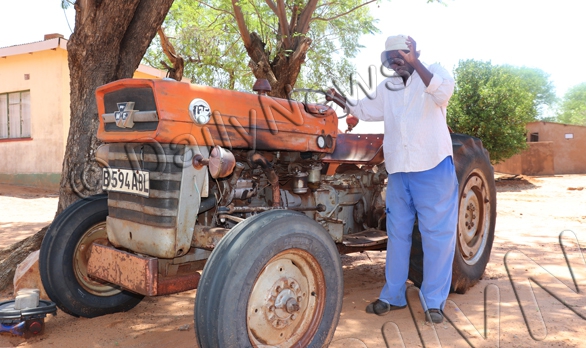Dikgale brothers soldier on
24 Nov 2019
Odds are stacked against these pensioners. Age is no longer on their side. It is the eve of the cropping season. The soil is soaking wet from the rare November showers.
Optimism is pitched high with fingers crossed for the November rains to signal the end of a severely prolonged drought. The past 10 years, beginning with the year 2011, have not been easy.
Farmers, both pastoral and arable, bear the brunt of such. Livestock and arable farming depend on annual seasonal rainfall. But this past decade, the country has received little rainfall, which came in erratic sequence.
The most prevalent feature of the period under discussion was the unforgiving and unrelenting heat. In its trail, the drought left farmers in financial ruin.
Worse off were arable farmers. Conversely, cattle farmers, depending on their capacity, have the opportunity to salvage their stock.
Oh! Thanks to government subsidies, pastoralists are aided to buy feeds or supplements for their animals. “That is not so with arable farmers. Once crops fail, you are ruined. This has been going on and on for years now,” laments Mr Isaac Dikgale, one of Leshibitse’s prominent farmers.
The Octogenarians and Septuagenarians of Leshibitse are not letting the odds weigh them down forever though. Despite their advanced age, Dikgale brothers, second generation of Pedi emigrants, whose fathers crossed Limpopo River and settled in Leshibitse in the late 1950s, are determined to continue producing grain, no matter the costs.
One would readily assume they had all read and strongly believe in the words of D. H. Lawrence in Lady Chatterley’s Lover.
“Ours is essentially a tragic age, so we refuse to take it tragically. The cataclysm has happened, we are among the ruins. We start to build up new little habitats, to have new little hopes. It is rather hard work: there is now no smooth road into the future: but we go round, or scramble over the obstacles. We’ve got to live, no matter how many skies have fallen.”
Messrs Obadia, Hans, Isaac and Gerrard Dikgale are in a mean mood not to let the crippling drought and attendant obstacles to curtail their farming careers. In fact, they are busy organising themselves to return to the career they know best. A career that they are not intending to retire from anytime soon.
They told of their story of their coming to Botswana beginning in 1956. The elder of the brothers, Mr Obadia Dikgale, says their forbearers, Livy Dikgale, Theophelus Dikgale, Obadia Makgopa and Phineas Makgalapa led their four families from the then Transvaal Province of South Africa near present day city of Polokwane to seek farming land in GaMmangwato. He says the four reached Serowe on June 26, 1956 whereupon they met Kgosi Kgamane who then allowed them to settle in Tsetsejwe.
Mr Dikgale explains that chief among their fathers’ motives of coming to Botswana, was to buy farm land after word had reached them that farms were being sold in what would later become Botswana. He explains that when they met Kgosi Kgamane, they got to establish that land in GaMmangwato was not being sold but people were being allocated pieces to use for free.
Mr Dikgale says his families settled in Tsetsejwe until they were suspected of being members of the Zion Christian Church. That was at the time other ZCC members were being persecuted in places like Mochudi, a situation that culminated with the relocation of ZCC members to Lentswe-le-Moriti near Tuli Block. Hans Dikgale reckons that initially, the pioneers denied being members of the ZCC until, during a search, a certificate of baptism of one of them dropped from the pass-book. That was a period during which Black people were required to carry pass books when travelling around South Africa. He says that caused their expulsion from Tsetsejwe whereupon they returned to South Africa.
Determined to resettle in what would later become Botswana, the party of four, would cross Limpopo River again in 1957, this time around to meet Kgosi Molefhi of Bakgatla-ba-Kgafela about the prospects of settling in his territory. Mr Dikgale says their application won Kgosi Molefhi’s favour, having been impressed by their agricultural implements and allowed them to set up at Leshibitse. Cattle, ploughs, ox-wagons, previously abandoned at Tsetsejwe, were ferried to Palapye, then loaded onto the train for Artesia.
Mr Dikgale further explains that his father and uncles were extremely delighted to be afforded, arguably the best and most valuable, piece of agricultural land in Kgatleng endowed with the most fertile soil. He recalls where Kgosi Molefhi stood on an elevated ground showing their forbearers a basin shaped savanna grassland which would become their home ever since.
“Lefatshe leo le ne la agelelwa ka pela ga bo go simololwa go lengwa one ngwaga oo,” reckons Mr Dikgale, meaning that the piece of land was quickly fenced and ploughing followed immediately.He regrets that Kgosi Molefhi would die the following year (1958) before he could appreciate their first harvest. A year later, the four collaborated in the establishment of a primary school in Leshibitse, an idea he says was deemed crazy by the local Kgatla populace.
Mr Dikgale adds that in 1960, motivated by their neighbours’ bumper harvest in Mookane in GaMmangwato territory, would dispatch one of the brothers on a solo cycling expedition to Mahalapye to ask for technical expertise from local authorities. The brothers say two agricultural demonstrators were deployed to Leshibitse.
They credit the demonstrators, among them a dedicated Morolong native by the name Tselane, for exposing them to new farming techniques. The Dikgale brothers say that marked the dawn of a very successful farming career in Leshibitse until the 2000s when their fortunes started experiencing a serious knock.
The current drought spell would compound their already dire situation. To sum up the current situation, Mr Hans Dikgale says “Ke simolotse go hakgamala ke bona dikgetsi di le 300 tsa mabele,” meaning that what struck him was when the harvest would only realise 300 bags of sorghum.
Obadia, Hans, Isaac and Gerrard now lament old age.
The unfortunate thing they reckon, is that most of their children are too skeptical about venturing into arable farming. Not surprising though considering the level of risks involved. However, the four Dikgale bothers say there are some among their children, like Edwin Dikgale, who have already demonstrated that they have what it takes to continue their forefathers’ legacy.
Leshibitse is situated along Masama Well-Fields where government recently began extracting water to augment greater Gaborone’s water supply. Dikgale brothers say had they discovered the wealth below their ground at the peak of their careers, they could have long ventured into irrigation for precision farming.
The brothers cannot help imagining the Ogallala Aquifer in the United States of America located beneath the Great Plains. Ogallala is one of the world’s largest aquifers, spread across eight states of South Dakota, Nebraska, Wyoming, Colorado, Kansas, Oklahoma, New Mexico and Texas.
Literature indicates that presently, about 30 per cent of the irrigated land in the entire United States lies over the aquifer, which accounts for about 30 per cent of the ground water used for irrigation in the United States.
The Ogallala Aquifer was turned to commercial agriculture in the aftermath of World War II following a life changing discovery by Nebraskan native, Frank Zybach. Literature says Zybach, then living in the nearby state of Colorado thought of a super sprinkler that could transform farming as it was known then. The idea led him to the invention of the native of Nebraska State, then living in neighbouring Colorado, to invent the Centre Pivot. ends
Source : BOPA
Author : Aupa Mokotedi
Location : MOLEPOLOLE
Event : Interview
Date : 24 Nov 2019







